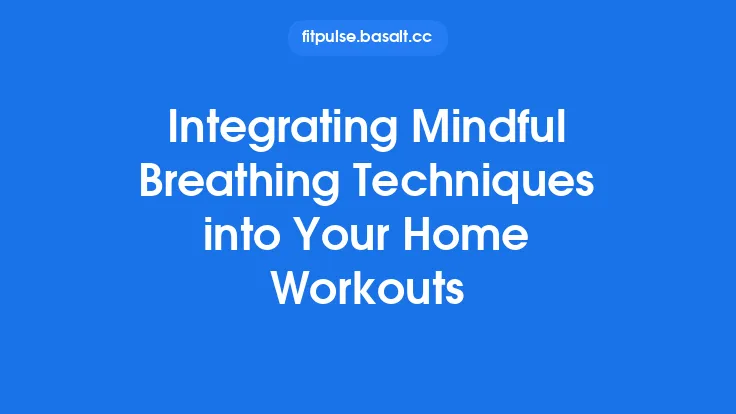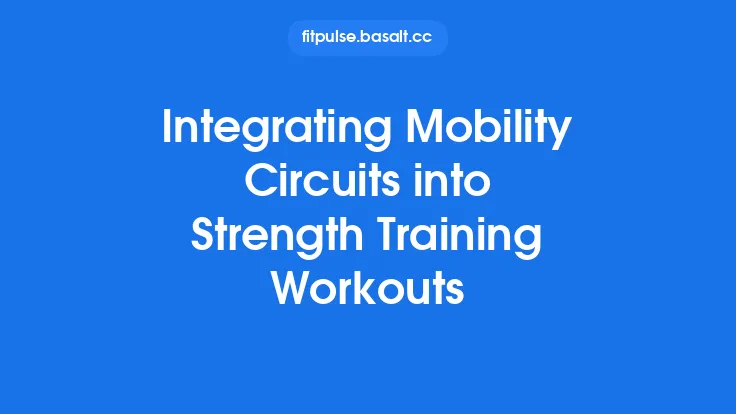Integrating AI coaching into home workouts without specialized equipment is now a realistic option for anyone who wants a personalized, data‑driven fitness experience without investing in pricey hardware. The key lies in combining the processing power of modern smartphones, laptops, or tablets with advances in computer‑vision, audio analysis, and on‑device machine‑learning models. Below is a step‑by‑step guide that walks you through the technical foundations, practical implementation, and best‑practice considerations for building an effective AI‑driven home‑gym that relies only on the devices you already own.
Understanding the Foundations of AI Coaching
AI coaching is essentially a feedback loop: the system observes your movement, interprets the data, compares it against a model of the desired exercise, and then delivers actionable cues. The loop can be broken down into four core components:
- Sensing – Capturing raw data (video, audio, inertial signals) using built‑in sensors.
- Interpretation – Applying machine‑learning models (pose estimation, activity classification) to translate raw signals into meaningful metrics such as joint angles, repetition counts, or tempo.
- Personalization – Adjusting the target metrics based on user profile, historical performance, and stated goals.
- Feedback Delivery – Communicating corrections or encouragement through visual overlays, audio prompts, or haptic signals.
When specialized equipment (e.g., wearables, force plates) is unavailable, the sensing stage relies heavily on sensor‑free techniques, primarily computer‑vision and audio analysis. Modern AI frameworks have made these techniques both accurate enough for fitness use and lightweight enough to run on consumer devices.
Leveraging Everyday Devices for Sensor‑Free Tracking
| Device | Built‑in Sensors | Primary Use Cases |
|---|---|---|
| Smartphone | Rear/front camera, microphone, accelerometer, gyroscope | Pose estimation via video, cadence detection via audio, motion cues from inertial data (when phone is placed on a mat) |
| Laptop / Tablet | Webcam, microphone | Real‑time visual feedback, voice‑guided cues |
| Smart TV / Streaming Stick | Camera (optional), remote control | Large‑screen visual overlay for group workouts |
| Smart Speakers (audio‑only) | Microphone, speaker | Voice prompts and rhythm detection (e.g., counting beats for cardio) |
Key Insight: Even a single camera can provide a surprisingly rich data stream. By extracting 2‑D keypoints (e.g., shoulders, hips, knees) and projecting them into a 3‑D skeleton using depth‑estimation models, the system can infer joint angles and movement quality without any external markers.
Core AI Techniques for Equipment‑Free Coaching
1. Pose Estimation
- Model families: OpenPose, MediaPipe Pose, BlazePose, and newer lightweight transformer‑based models.
- How it works: The model processes each video frame, detects a set of 33 (or more) anatomical landmarks, and outputs their pixel coordinates. Some models also provide confidence scores for each landmark.
- Implementation tip: Use a frame‑skip strategy (e.g., process every 3rd frame) to reduce CPU/GPU load while maintaining smooth feedback. Most modern smartphones can handle 15–30 fps with these models.
2. Activity Classification
- Approach: Feed a short temporal window (e.g., 2 seconds) of pose keypoints into a recurrent neural network (RNN) or temporal convolutional network (TCN) to classify the exercise (squat, push‑up, lunge, etc.).
- Why it matters: Accurate classification ensures the feedback logic applies the correct biomechanical thresholds (e.g., depth for a squat vs. range for a push‑up).
3. Repetition Counting & Tempo Detection
- Signal processing: Compute the angle of a primary joint (e.g., knee angle for squats) over time. Peaks and troughs correspond to the concentric and eccentric phases.
- Algorithm: Simple peak‑detection with hysteresis thresholds works well; for noisy data, apply a low‑pass filter (e.g., Butterworth) before detection.
4. Audio‑Based Rhythm & Breathing Guidance
- Beat detection: Use short‑time Fourier transform (STFT) on microphone input to extract tempo for cardio or interval training.
- Breathing cues: Generate a sinusoidal audio cue (inhale/exhale) synchronized to the detected tempo, helping users maintain optimal breathing patterns without a separate sensor.
Personalizing Workouts Without Equipment
Even without external hardware, AI can tailor workouts by leveraging user‑provided data and historical performance:
- Initial Profile Survey: Age, gender, fitness level, injury history, and goal (strength, endurance, mobility). This information seeds the baseline model.
- Dynamic Difficulty Adjustment: After each session, the system evaluates metrics such as average range of motion, repetition quality, and fatigue (inferred from decreasing speed). If the user consistently exceeds the target thresholds, the AI nudges the difficulty up (e.g., deeper squat, faster tempo). Conversely, a drop in quality triggers a temporary regression.
- Progressive Overload via Volume: Since load cannot be increased without weights, the AI focuses on volume (more reps, longer sets) and time under tension (slower eccentric phases) to drive adaptation.
- Movement Variations: The AI can suggest alternative body‑weight variations (e.g., Bulgarian split squat instead of regular squat) to target the same muscle groups while keeping the stimulus novel.
Designing the Feedback Loop
Effective feedback hinges on timing, modality, and clarity:
- Real‑Time Visual Overlays
- Skeleton Highlighting: Color‑code joints that are out of range (e.g., red for insufficient depth).
- Target Zones: Draw semi‑transparent arcs indicating the ideal trajectory for a limb.
- Repetition Counter: Display a large, unobtrusive number in the corner.
- Audio Prompts
- Immediate Corrections: “Raise your hips a bit higher,” delivered within 300 ms of detection.
- Encouragement: “Great form! Keep it up,” at the end of each set.
- Safety Alerts: “Pause—your knee alignment is off,” if a risky deviation persists for more than two seconds.
- Haptic Feedback (Optional)
- If the user holds a phone or smartwatch, short vibration bursts can signal the start/end of a rep, useful when visual attention is elsewhere.
Best Practice: Keep the total latency under 500 ms. Higher latency can cause a disconnect between the user’s perception and the AI’s cue, reducing effectiveness.
Integrating with Existing Fitness Platforms
Many users already rely on popular workout apps (e.g., YouTube playlists, calendar‑based plans). AI coaching can be layered on top without replacing these ecosystems:
- API Hooks: Use the app’s schedule data to trigger the AI session automatically.
- Exportable Metrics: After each workout, generate a CSV or JSON file containing reps, range of motion, and quality scores. Users can import this into spreadsheet tools or health dashboards.
- Cross‑Device Sync: Store session data locally on the device and optionally sync to a cloud service (e.g., Google Drive) for backup—ensuring privacy by keeping the data encrypted and user‑controlled.
Overcoming Common Technical Challenges
| Challenge | Typical Symptom | Mitigation Strategy |
|---|---|---|
| Lighting Variability | Pose keypoints jitter or disappear in low light. | Encourage a well‑lit environment; implement adaptive exposure control; fallback to grayscale processing to reduce noise. |
| Background Clutter | Model confuses furniture with body parts. | Use background subtraction or a simple segmentation model (e.g., MediaPipe Selfie Segmentation) to isolate the user. |
| Device Performance Limits | Dropped frames, laggy feedback. | Deploy quantized models (e.g., TensorFlow Lite with 8‑bit integers) and use GPU/Neural Engine acceleration where available. |
| User Positioning | Camera angle too high/low, causing inaccurate joint angles. | Provide an on‑screen guide (“Place the camera at chest height”) and a quick calibration routine that asks the user to perform a reference pose. |
| Audio Interference | Ambient noise masks beat detection. | Apply noise‑gate filtering and focus on dominant frequency bands; optionally allow the user to wear simple earbuds for a cleaner microphone signal. |
Practical Workflow for a Beginner
- Setup
- Place a smartphone on a stable surface at eye level, facing the workout area.
- Open the AI coaching app and run the “Calibration” routine (stand straight, perform a squat, a push‑up).
- Select a Program
- Choose a body‑weight routine (e.g., “Full‑Body 20‑Minute Circuit”). The AI loads the appropriate activity classifiers.
- Start the Session
- The app begins video capture, displays a semi‑transparent skeleton, and counts down.
- During Exercise
- Real‑time visual cues highlight any deviation.
- Audio prompts give brief corrections (“Keep your elbows close to your torso”).
- Post‑Session Review
- Summary screen shows total reps, average depth, and a “quality score” (0–100).
- Recommendations for the next session (e.g., “Add 2 extra reps per set” or “Slow down the eccentric phase by 1 second”).
- Log & Iterate
- Export the session data to a personal spreadsheet. Over weeks, track trends and adjust goals accordingly.
Future Directions (Beyond the Scope of This Article)
While this guide focuses on current, equipment‑free solutions, the field is rapidly evolving. Emerging research in edge‑AI promises even more sophisticated biomechanical modeling on‑device, and multimodal fusion (combining video, audio, and inertial data) will improve robustness in challenging environments. Developers should keep an eye on open‑source model releases and community benchmarks to stay ahead of the curve.
Final Thoughts
Integrating AI coaching into home workouts without specialized equipment is no longer a futuristic concept—it’s a practical reality built on accessible hardware and open‑source machine‑learning tools. By understanding the core sensing‑interpretation‑feedback loop, leveraging everyday devices, and applying lightweight pose‑estimation and activity‑classification models, anyone can create a personalized, data‑driven fitness experience at home. The key to success lies in thoughtful implementation: maintain low latency, provide clear multimodal feedback, and continuously adapt the program based on measurable performance metrics. With these principles in place, AI becomes a silent, ever‑present trainer that helps you stay consistent, safe, and progressively challenged—right from the comfort of your living room.





